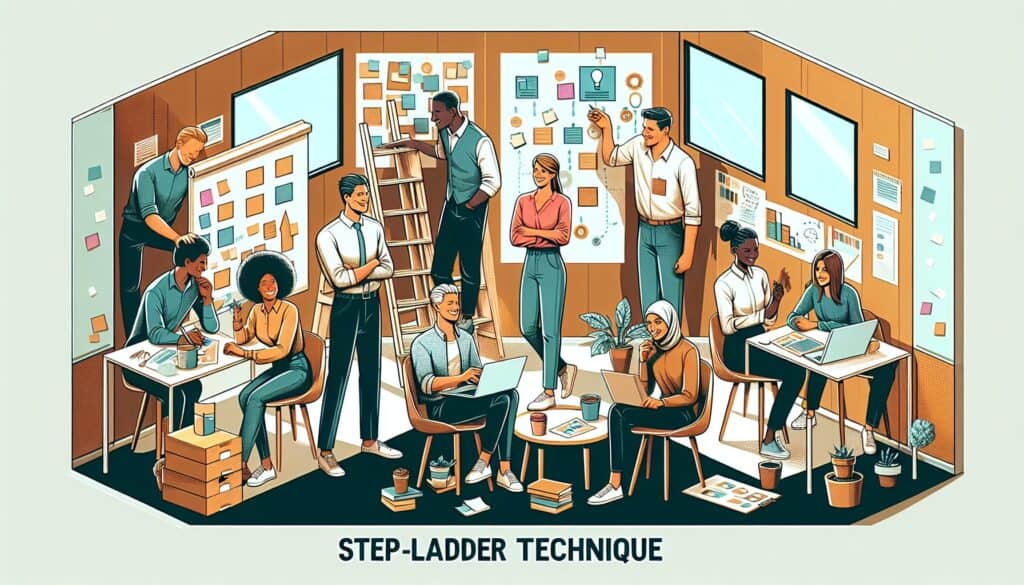Eine strukturierte Gruppenentscheidungs- oder Brainstorming-Technik, die sicherstellen soll, dass alle Mitglieder ihre unabhängigen Gedanken einbringen, bevor sie von der Gruppe beeinflusst werden.
- Methodologien: Maschinenbau, Qualität
Stufenleitertechnik

Stufenleitertechnik
- Brainstorming, Kreativität, Funktionsübergreifende Zusammenarbeit, Design Denken, Innovation, Problemlösungs-Techniken, Teamarbeit, Benutzerzentriertes Design, Wert-Angebot
Zielsetzung:
Wie es verwendet wird:
- Zwei Kernmitglieder diskutieren das Problem. Dann stellen weitere Mitglieder nacheinander ihre Ideen vor, bevor sie die erste Diskussion hören. Nachdem jedes neue Mitglied seine Idee vorgestellt hat, diskutiert die Gruppe über alle bisher vorgestellten Ideen.
Vorteile
- Fördert das unabhängige Denken aller Mitglieder; trägt dazu bei, frühe Konformität oder Dominanz durch durchsetzungsfähigere Personen zu verhindern; führt in einigen Fällen zu qualitativ besseren Entscheidungen.
Nachteile
- Kann zeitaufwändig sein, insbesondere bei größeren Gruppen; erfordert eine sorgfältige Steuerung des Eingabe- und Diskussionsprozesses; eignet sich möglicherweise nicht für sehr dringende Entscheidungen.
Kategorien:
- Ideenfindung, Problemlösung
Am besten geeignet für:
- Verbesserung der Entscheidungsfindung in der Gruppe, indem sichergestellt wird, dass alle Mitglieder ihre individuellen Ideen einbringen, bevor sie von der größeren Gruppe beeinflusst werden.
The Step-Ladder Technique is highly applicable in various sectors such as technology, healthcare, and automotive design, where teams are often tasked with solving intricate problems that require diverse perspectives for effective solutions. This methodology is particularly useful during the ideation phase of a project when the team is brainstorming solutions for new products or improvements. Typically, the process begins with two core members sharing their thoughts on the problem at hand, creating a baseline of ideas that new team members can build upon when they present their contributions one by one. This approach can involve engineers, designers, product managers, or even stakeholders who might impact the final decision. Each new member’s contribution is discussed in the context of previous suggestions, avoiding premature convergence on a single idea and ensuring that each voice is heard. This method promotes independent thought and minimizes the risk of groupthink, which is often prevalent in collaborative environments, especially when a few dominant personalities may sway the discussion. As such, companies using this technique often report enhanced creativity and innovation due to the varied viewpoints being considered. In settings where high-stakes decisions are required, such as clinical environments or product safety assessments, the Step-Ladder Technique can ensure that all sides of an issue are deliberated and that the final decision is informed by a comprehensive understanding of the problem, leading to more robust outcomes that reflect a wider range of experiences and expertise.
Die wichtigsten Schritte dieser Methodik
- Two core members discuss the problem and generate initial ideas.
- Each additional member presents their ideas one at a time.
- After each new member presents, facilitate a discussion of all ideas shared so far.
- Encourage refinement and evaluation of ideas through further discussion.
- Continue this process until all members have contributed their ideas.
- Conclude the session with a comprehensive discussion incorporating all ideas shared.
Profi-Tipps
- Integrate role rotation within the group to enhance diverse viewpoints and counteract any single member's bias during discussions.
- Utilize time-boxing for each member's idea presentation to maintain engagement and encourage concise expressions of thoughts.
- Incorporate anonymous feedback mechanisms after discussions to assess satisfaction with solutions and further uncover any overlooked insights.
Verschiedene Methoden lesen und vergleichen, Wir empfehlen die
> Umfassendes Methoden-Repository <
zusammen mit den über 400 anderen Methoden.
Ihre Kommentare zu dieser Methodik oder zusätzliche Informationen sind willkommen auf der Kommentarbereich unten ↓ , sowie alle ingenieursbezogenen Ideen oder Links.
Historischer Kontext
1960
1980
1983
1990
1995
2000
2010
1950
1980
1980
1986
1994
1995
2000
(wenn das Datum nicht bekannt oder nicht relevant ist, z. B. "Strömungsmechanik", wird eine gerundete Schätzung des bemerkenswerten Erscheinens angegeben)














Verwandte Artikel
Management der Produktionsabläufe (MOM)
Fertigungsausführungssystem (MES)
Produktionslenkungsplan
Manuelle Prüfung
Bewertungsbögen für die manuelle Handhabung (MAC)
ManTRA (Instrument zur Risikobewertung manueller Tätigkeiten)